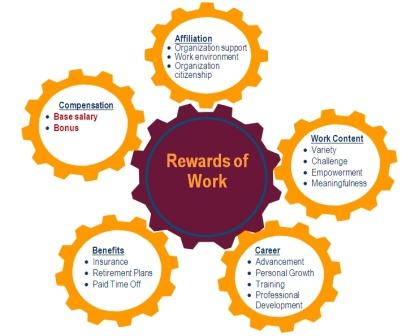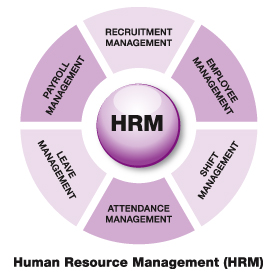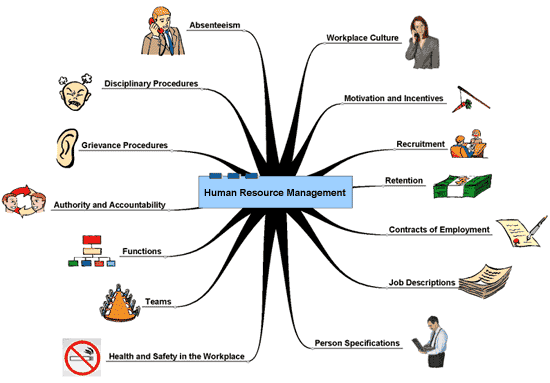Reward System
Before discussing the elements of a reward systems, their aims, other issues related to design strategic reward system, reward strategies, implementation of chosen strategy along the evaluation; it seems worthwhile to explain the reward system which would make the discussion coherent. Armstrong (2004:4) explains the reward system in very lucid words as he regards employee reward system, an organizations’ integrated policies, processes and practices through which organization reward their employees on the basis of their skill, competence, their market worth and their overall contribution to the organization.
A reward system could include financial rewards (fixed and variable pay) and employee benefits, which together comprise total remuneration. The system also incorporates non- financial rewards (Recognition, praise, achievement, responsibility and personal growth) and in many cases, performance management processes. The non-financial compensation, financial rewards and employee benefits form the total reward system (Armstrong, 2004).
Aims and Purpose of a Reward System
Armstrong & Murlis (2007) put forward number of aims of reward management/system which are very helpful to understand what businesses want to drive through these reward systems which are as follows:
- To create total reward processes that are based on beliefs about what the organization values and wants to achieve;
- To reward the employees for the value they have created for the organization;
- To bring into line the reward practices with the employee values and business goals and objectives;
- To develop the positive psychological contract and employment relationships with the employees;
- To reward right behaviours in order to deliver the positive message to the employees that what organization expects from them in terms of outcomes and behaviours;
- To win the war of the talent by attracting and retaining the talented, skilled and competent pool of employees that organization need to make the difference;
- To gain the commitment and engagement of the employees by motivating them through reward practices;
- To cultivate and sustain the performance culture within the organization.
Structural Design Issues of Reward system
There are number of options for the organization to design its reward system because there are number of ways through which rewards are given and distributed among the employees in the organization. The reward’s content dimension or structural dimension denotes the practices (e.g. the performance appraisal forms, and the salary structure), formal procedures and mechanisms (Lawler, 1993). In relation to the structural dimension, there are many issues which organization will have to address, some of them are briefly discussed below:
- Market Position- the organizational preference and its market position would influence not only the organizational environment but also the reward strategy. If business wants itself ahead of its competitors, it would rather go for setting the higher pay levels than the competitors. If organization sees its employees less important for the organizational effectiveness, it would be likely to have different reward system (Marchington & Wilkinson, 2005).In conclusion, market position of organization could influence its overall structural design of reward strategy.
- Structure- the structural choice of organization also influence the organization overall reward system as what type of structure, an organization wants to pursue whether it would like to have the flexible and broad banded structure or comparatively formal (narrow-banded) and hierarchical (Armstrong, 2004).
- Reward Priorities-The organizational reward priorities have influence on the reward system. Organization decides whether it has to limit the reward to the small number of key players only or it wants to share the reward many in the organization in order to support the steady improvement of many (Armstrong, 2004).
- Reward Mix- The form of rewards actually shows that what type of culture or environment an organization wants to cultivate and maintain. Whether it wants to give the mix of rewards (base pay, benefits, non-financial reward) or it allows employees to choose their own package (such as Cafeteria-Style Approach) influence the overall reward system (Marchington & Wilkinson, 2005).
Strategic Reward
According to Armstrong & Murlis (2007:30)‘’Strategic reward management is the process of looking ahead at what an organization needs to do about its reward policies and practices in the middle or relatively distant future’ ’It enables the organization to drive its reward management to deal with the wider business issues for obtaining its long-term business goals (Armstrong & Murlis, 2007).
Reward Strategies
Reward strategy drives an organization to achieve business goals by developing and implementing the reward practices, processes and policies in order to address critical reward issues in the long-term (Armstrong & Brown, 2006:31). The three reward strategies are discussed below along with their strengths and weaknesses:
- Financial Rewards: -A various ways by which a company can gives money to its employees is known as financial rewards. According to Armstrong (2007), financial rewards can be the one of the component that could motivate people in the workplace to work hard and to be able achieve higher standard as these rewards will be only given if the workers are competent in their jobs. These rewards come in ‘Pay packages’ such as salaries, fringe benefits, time-rate pay, commission, performance-related pay and pensions. However, the drawback of the rewards is that the company might not be able to pay the market rate and can be at the risk of losing a worker if the others organizations are offering higher standard of pay mix.
- Non-Financial Rewards: -Some businesses find non-financial rewards methods are more approachable when it comes to motivate staff and it involves indirect payments. An achievement, autonomy, recognition, scope to use and develop skills, training, career development opportunities and high quality leadership which concerned with expectations and self-efficacy all are a part of non-financial rewards (Armstrong, 2007). These rewards can boot employee’s confidence and can satisfy employees. The possible downside of the reward could be that the employees can have better opportunities in the competitors company, who are willing to offer financial rewards along with non-financial rewards.
- Total Reward Strategy:-According to Manus & Graham (2003) as cited in Armstrong (2006:629)‘’ total reward includes all types of rewards- indirect as well as direct, and intrinsic as well as extrinsic’ ’This strategy is proved to be very successful for many companies who implemented this strategy to motivate their employees as mentioned by Armstrong (2006). This is the holistic strategy in which every aspect of reward practices are employed so employees could gain satisfaction through their work Armstrong (2006). Maintaining the balance in financial and non-financial reward while pursuing according to the organization’s circumstances could be very difficult for the organization which could be regarded as the weakness for using this approach.
Implementation of Chosen Strategy
The chosen strategy of total reward could be implemented as it has number of benefits and it incorporates both the financial and non-financial rewards. Developing reward strategy is easy but implementation is hard. According to Armstrong (2006), implementation initiates the challenge of change management. The guidelines for implementation of chosen strategy which are as follows:
- The value in-depth employee consultation should never be undervalued.
- Without looking at the return on investment, no initiative should be implemented.
- Actions should be taken as required and effectiveness of programmes should be evaluated.
Evaluation and Monitoring of Implemented Reward Strategy
After implementing the reward strategy, through number of ways effectiveness of implemented reward strategy is assessed and evaluated. Armstrong (2010) puts forward number of suggestions to assess and evaluate the reward strategy as follows:
- A reward review should be done through gathering and researching from qualitative and quantitative information on the reward practices inside the organization.
- By using this information the effectiveness of the delivery of reward goals from various reward practices should be assessed.
- The time to time audit should be performed in order to evaluate the effectiveness of the reward investment.
- Through reward surveys, employees could be asked and analysed in order to monitor the effectiveness of the implemented reward strategy.

Motivation and Reward Practice
One cannot separate the process of motivation and the reward practices. It is very essential to comprehend those factors which motivate the employees and it would be recommendable for the organizations to design their reward strategies and practices in the light of those factors in order to increase performance of employees throughout the organization. Practical guidance is provided by the motivation theories in developing the reward systems. The theories of motivation tell that what factors exactly encourages individual, or group of employees to adopt something behaviour or to do something differently. These factors guide the human behaviour and could affect their efforts to do something (Armstrong, 2007). So, designing reward practices in the light of motivating factors could be very beneficial and effective.
Process Theory of Motivation and Reward
Porter & Lawler (1968) modified Vroom’s Expectancy Theory (1964) as cited in Morris & Vascular (2005:8) expectancy theory of behaviour. Bartol and Locke (2000, p. 111) as cited in Morris & Vascular (2005:8) state that expectancy theory “…holds that people make choices based on (1) their expectancy that their efforts will lead to a certain 8 level of performance, (2) their belief that their performance will lead to valued outcomes (instrumentality) and (3) the degree of value they place on those outcomes (valence).”
Expectancy theory underpins best fit thinking because it provides a design framework so that each element of a reward system can be used to the element’s best advantage. Lawler’s (1995) as cited in Morris & Vascular (2005) new pay model provides guidance on what behaviours to measure. They must be linked to organisational strategy. However, Lawler (1981, p. 22)as cited in Morris & Vascular (2005:8) emphasises in an earlier work, the importance of the implementation process when he states: “In order for employees to believe that a performance-based pay relationship exists, the connection between performance and rewards must be visible, and a climate of trust and credibility must exist in the organization.”
The measurement of performance is a critical characteristic of ‘new pay’. Armstrong (2002) as cited in Morris & Vascular (2005) emphasises the need for a robust performance management process. Schuster and Zingheim (1992, p. 210) as cited in Morris & Vascular (2005:8), states “measurement is the core of new variable pay because it provides the justification for sharing performance improvements with employees.”
Content Theory of Motivation and Reward
Best practice advocates rely on content theories of motivation as the basis of their reward systems. Herzberg (2003, p. 91) as cited in Morris & Vascular (2005:8) found ‘…that the factors involved in producing job satisfaction (and motivation) are distinct form the factors that lead to job dissatisfaction.’ Motivators, the source of job satisfaction, are intrinsic to the job including ‘achievement, recognition for achievement, the work itself, responsibility and growth or advancement.’ (Herzberg, 2003, p. 92) as cited in Morris & Vascular (2005:8) Hygiene factor, including salary, are extrinsic to the job and are a potential source of job dissatisfaction.
Performance Related Pay
Provision of financial rewards in terms of increment in the basic pay or any cash bonuses after assessment of the individual’s performance against the set objectives is regarded as performance related pay (Armstrong, 2002). Research and surveys show the both negative and positive aspect of the performance related pay.
One survey showed that, 14% respondents have opinion that PRP has made the fairness worse, 67% respondents have opinion that it conveys the message of clarity regarding performance of organization, while 57% respondents thinks it is fair to be get rewarded by performance related pay (Armstrong, 2002). However, study of IPM in 1997 found no relationship between the performance-related pay and the enhanced organizational performance (Armstrong, 2002).
When decisions are being in regards to the type of reward system, the main strategic decision that needs consideration is whether or not the reward system will be made on the basis of performance, which allows most of the reward systems feature to fit into the right places. However, it could also be based on seniority. In most government agencies, the pay rates are based on factors such as the roles of the employee and the length of their service. Although, in Japan, seniority is mostly used to decided individual pays, employees also receive bonuses based on the performances of the corporate (Lawler 1993).
According to Milkovish and Wigdor (1991) as cited by Lawler (1993), in America, most businesses use individual performances to reward its employees using the pay system and promotion system which is known as merit systems in America. Although it is believed that having a merit pay or promotion system in place helps businesses stay organised but according to Kerr (1975) as cited in Lawler, (1993) it is better to keep pay and promotion separate from performance and find ways to improve performances of an individual. There is a lot of evidence (Whyte, 1955; Lawler, 1971; Schuster and Zingheim, 1992 as cited in Lawler, 1993) that suggest that having a merit system could be harmful.
In order to improve team work and produce integration, organisational and group bonus plans have proven to be effective. A group and organisational plan means that everyone contributes towards the financial results of higher performance. Therefore, an individual work effectively and efficiently as everyone support, empower and encourage each other. People are more likely to empower and support others workers if they feel their performance would benefit them which is less likely to happen under individual plans as it increase competition and differentiation (Lawler 1993).
There are other factors that could arise from using performance based reward system such as poor practise, small rewards and failure to explain the system. Nevertheless, it is hard to determine whether or not pay should be based on performance as there is a lot of evidence to support the system. In conclusion, the negative impact of having such systems should not be overlooked (Lawler 1993).
Reference
Armstrong, M. (2004), Employee Reward: 3rd ed. London: Chartered Institute of Personnel and Development.
Armstrong, M. (2006). A handbook of employee reward management and practice. 2nd ed. Philadelphia: Kogan Page Limited
Armstrong, M. (2007), A Handbook of Human Resource Management Practice. 10th ed London.
Armstrong, M. and Brown, D. (2006), Strategic Reward: Implementing More Effective Reward Management: 2nd. Philadelphia.
Armstrong, M. and Murlis, H. (2007), Reward Management: A Handbook of Remuneration Strategy and Practice. 5th ed. Philadelphia.
Armstrong, M., Brown, D. and Reilly, P. (2010), Evidence-Based Reward Management: Creating Measurable Business Impact from your pay and reward practices. Philadelphia.
Lawler, E.E. (1993) Effective Reward Systems: Strategy, Diagnosis, Design, and Change. Online.
Marchington, M and Wilkinson, A. (2005). Human Resource Management at Work: People Management and Development. 1st ed. London: Chartered Institute of Personal and Development.
Morris, D. & Vascular, M. (2005) Strategic Reward Systems: Understanding the difference between ‘Best Fit’ and ‘Best Practice’. Online.
Armstrong, M. (2004), Employee Reward: 3rd ed. London: Chartered Institute of Personnel and Development.



